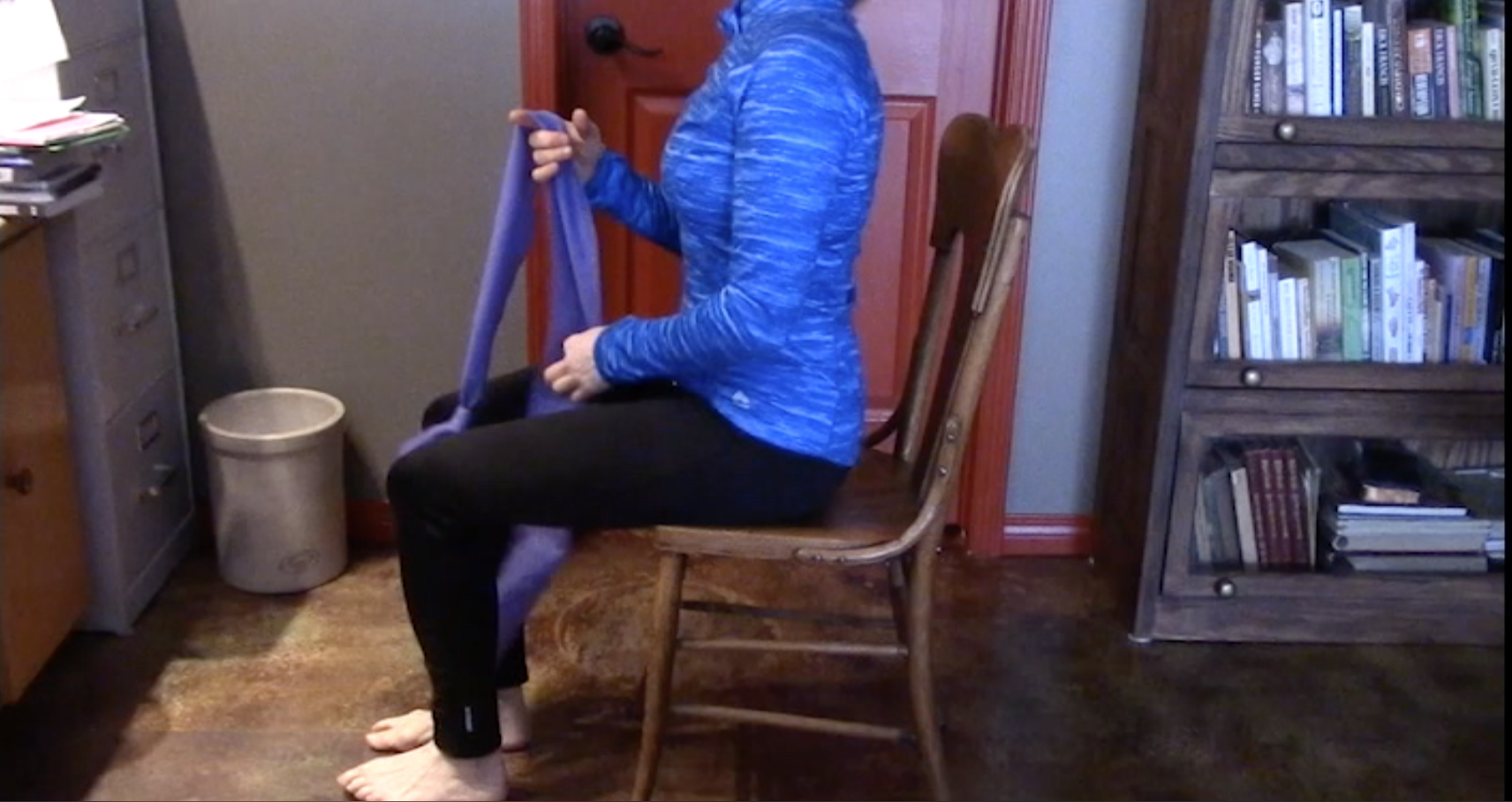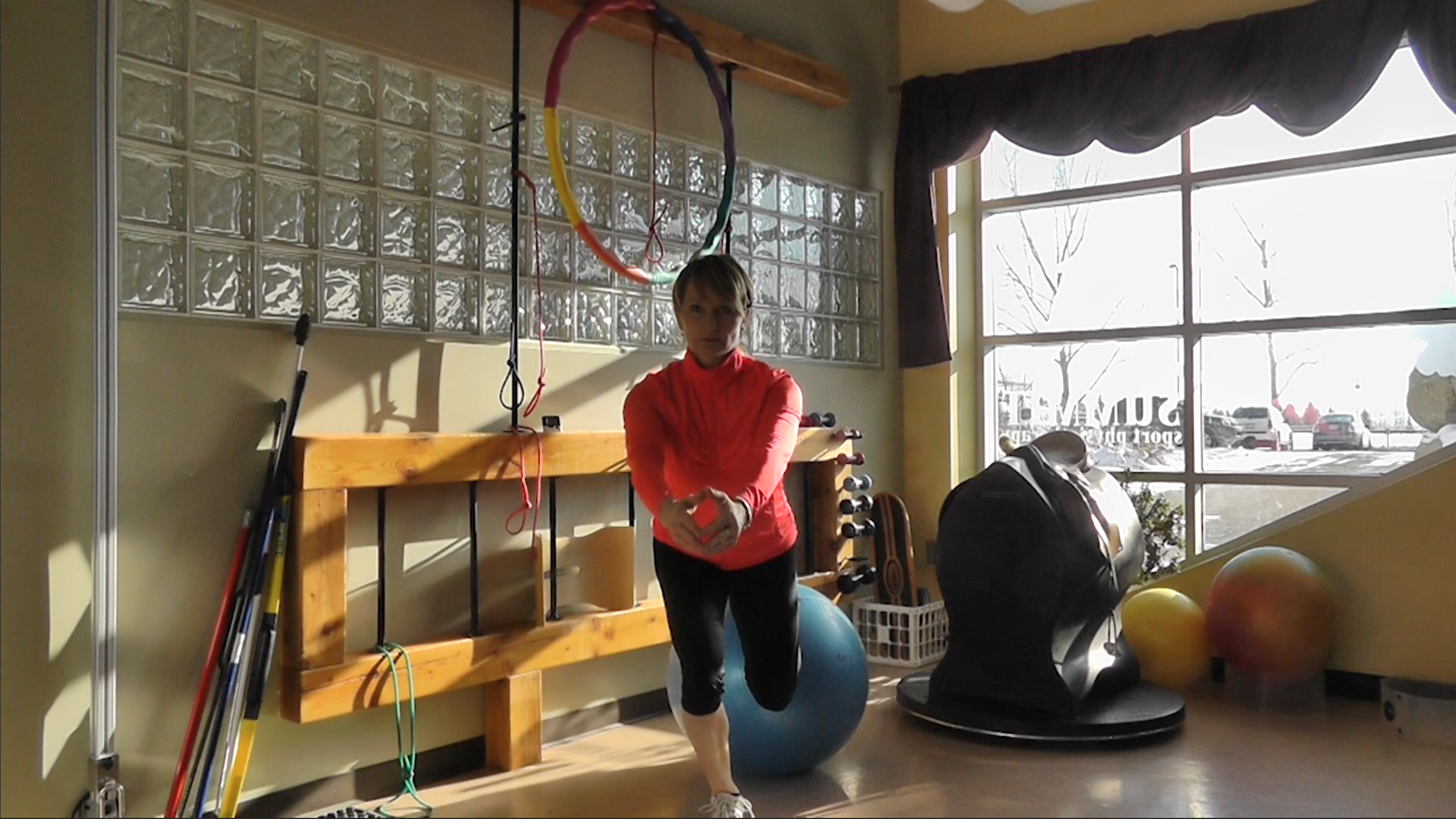Sit to Stand Exercise
No-stirrup work, friend or foe?
Many jumper riders assume that one can never do too much ‘no-stirrup’ work. It is commonly thought that the inner thigh muscles (adductors) are what keep a rider in the middle and on top of the horse, and that the stronger the inner thigh is, the better. A strong inner thigh is good for having effective aids and for staying on when the horse suddenly goes more sideways than forward. However, a strong outer hip muscle (gluteus medius) is of upmost importance. A weak outer hip will cause balance issues, crookedness and a loose lower leg or thigh far more than a weak inner thigh will. Doing 2-point or posting with no-stirrups can lead to knee pinching, stiff hips and back tension. All of which cause muscle pain or fatigue and may actually weaken a rider’s position. Doing a little bit of posting or 2-point at a time and spending more time in full seat, with the legs hanging long, will be much more beneficial! This will relax the hips, strengthen the core and make the outer hip work harder than the inner. Just the way it should be! A smarter way to train to have a stronger jumping position is to spend more time in 2-point with stirrups and in full seat without stirrups.
As a physiotherapist, I would rather see riders strength training more intensively off horse. The lunge squat and single leg jump squat that I discussed in previous ASJ issues are ideal. Add the ‘Sit to Stand’ exercise (that is on my website esportphysio.ca under the “Expert Advice’ tab) and your body will be much more balanced and able to withstand the rigors of riding. I see many young riders with back and hip pain and older riders with hip damage due to using the inner thigh too much. Strengthen your position, but train smarter, not harder!!
Squat Jump
Have you ever heard your coach say “step into your right/left stirrup” when you turn, especially after landing off a fence? Have you felt that you step heavier in one stirrup or sit more to one side in the saddle and for the life of you struggle to maintain equal weight? If so, it may be your body’s compensation for an injury anywhere in your body that occurred at any point in your life. It may also be because you are very one sided. You may feel the difference when you stand on one leg and do a hop with a very soft landing. A noticeable difference in the ability to balance or land softly after a few tries will probably demonstrate this asymmetry. The body will always take the easiest path or the path of least resistance and it is hard to convince it to do otherwise. One very useful exercise to create more balance in the stirrup or in the seat is demonstrated in the following video:
Power Posture: The best kept secret for strong, confident riding!
Most riders have heard “eyes up”, “look up”, “chin up”, or some other variation of that theme. Riders tend to look down. Why? Because that is where their hands are. Humans are wired to use their eyes to help their hands and since the hands are trying to affect the horse’s head and neck, that is where the eyes look.
So w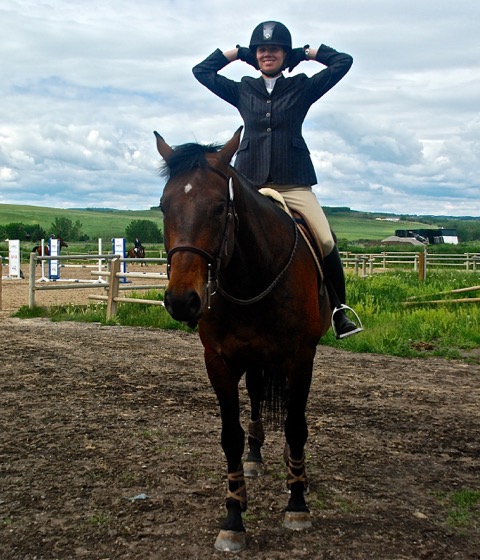 hy bother looking up? Well, the obvious reason is that you need to see where you are going to avoid collisions. Humans are wired so their body will orient them to where the eyes are looking. By looking to where you want to be, your muscle actions will send you in that direction. Useful when trying to ride a specific track!
hy bother looking up? Well, the obvious reason is that you need to see where you are going to avoid collisions. Humans are wired so their body will orient them to where the eyes are looking. By looking to where you want to be, your muscle actions will send you in that direction. Useful when trying to ride a specific track!
Another good reason to raise the eye level is to correct your posture. When looking down, the neck bends and the chain of muscles that runs from the base of the skull to the tailbone tightens. This reduces the mobility of the spine, limiting the rider’s ability to move ‘with the horse’. By gazing ahead, the rider’s spine maintains its normal curves and the core muscles work more effectively.
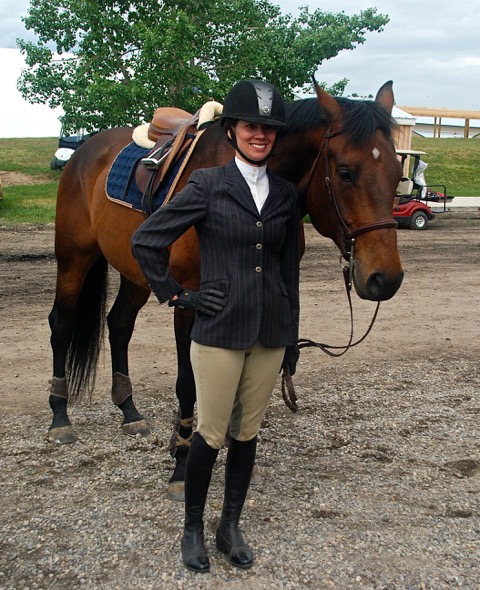 Possibly the most important reason to look up, especially in the show ring and even in daily life, is that it improves your confidence and even your mood. Adding a smile (whether you feel like smiling or not) makes it even better. Your physical being is able to directly affect your emotional and mental state. By using more ‘open’ and upright postures with positive facial expressions, you can very quickly improve your ability to perform mentally as well as physically. Some postures have been advocated as ‘power postures’ and adopting them periodically through the day as well as before and during riding, can have a substantial effect. Frequently looking down (can you say ‘texting’) weakens your body, causes poor posture and may affect your mood. So, sit up, smile and keep your gaze level with the horizon to feel, live and ride better!!
Possibly the most important reason to look up, especially in the show ring and even in daily life, is that it improves your confidence and even your mood. Adding a smile (whether you feel like smiling or not) makes it even better. Your physical being is able to directly affect your emotional and mental state. By using more ‘open’ and upright postures with positive facial expressions, you can very quickly improve your ability to perform mentally as well as physically. Some postures have been advocated as ‘power postures’ and adopting them periodically through the day as well as before and during riding, can have a substantial effect. Frequently looking down (can you say ‘texting’) weakens your body, causes poor posture and may affect your mood. So, sit up, smile and keep your gaze level with the horizon to feel, live and ride better!!
How to tighten your tummy muscles and get results fast.
 Everybody wants to exercise to strengthen their core, but realize when they go to bed at night that they didn’t get around to it. Some people throw in a few intense sit-up sessions randomly through the month and others give up because planks and sit-ups hurt their back.
Everybody wants to exercise to strengthen their core, but realize when they go to bed at night that they didn’t get around to it. Some people throw in a few intense sit-up sessions randomly through the month and others give up because planks and sit-ups hurt their back.
One of the most effective and easy to do exercises is what I call the abdominal wall exercise. All you need is a flat surface to lean against. Walk your feet two foot lengths away from the wall or pillar and lean against it such that your tailbone, middle back and back of head touch the wall. Relax your body and focus on breathing into your back so that the lower rib cage moves. Slowly push the bottom of your tailbone back into the wall as if you were trying to arch your lower back. BUT, don’t actually let your back arch by tightening your stomach muscles. If you feel tightening up your back, you have pushed too hard or not tightened your stomach muscles enough. KEEP BREATHING, WITH RIB CAGE MOVING. Hold for 5 breaths and relax for one. Repeat for 1-2 minutes.
You should feel your lower stomach muscles more than your upper. It is important that there is no tightening up the back or back pain. If there is you are pushing your tailbone back too hard and your back muscles are much stronger than your stomach muscles. Done correctly, you will have about 2 hours of increased core muscle activity even without thinking about it! So all you need to do is activate approximately every 2 hours through the course of your day starting first thing in the morning, perhaps while brushing your teeth. Once you get good at this you will be able to do it without the wall and can tighten your muscles even while walking down the stable aisle or sitting on your horse.
Correcting a ‘loose lower leg’.
A lower leg that swings, is too far back or jams forward is a common riding problem. The root cause for the lower leg to not correctly ‘wrap around’ the horse’s side is usually the pelvis being tipped too far back and the upper inner thigh muscles being tightened. This causes the thigh to rotate inward, which may appear as knee pinching. Gripping with the upper thigh activates muscles that turn the thigh inward (hence the knee pinching) and actually causes the inside of the calf to come off the horse. Many riders will compensate or be told to turn their foot out to get their calf ‘on the horse’. This correction may eventually cause pain in the outer foot, knee or calf area, increase use of the heel (and spur) when using their leg and will prevent their calf from absorbing the forces of landing off a jump. This may in turn cause loss of upper body control on landing.
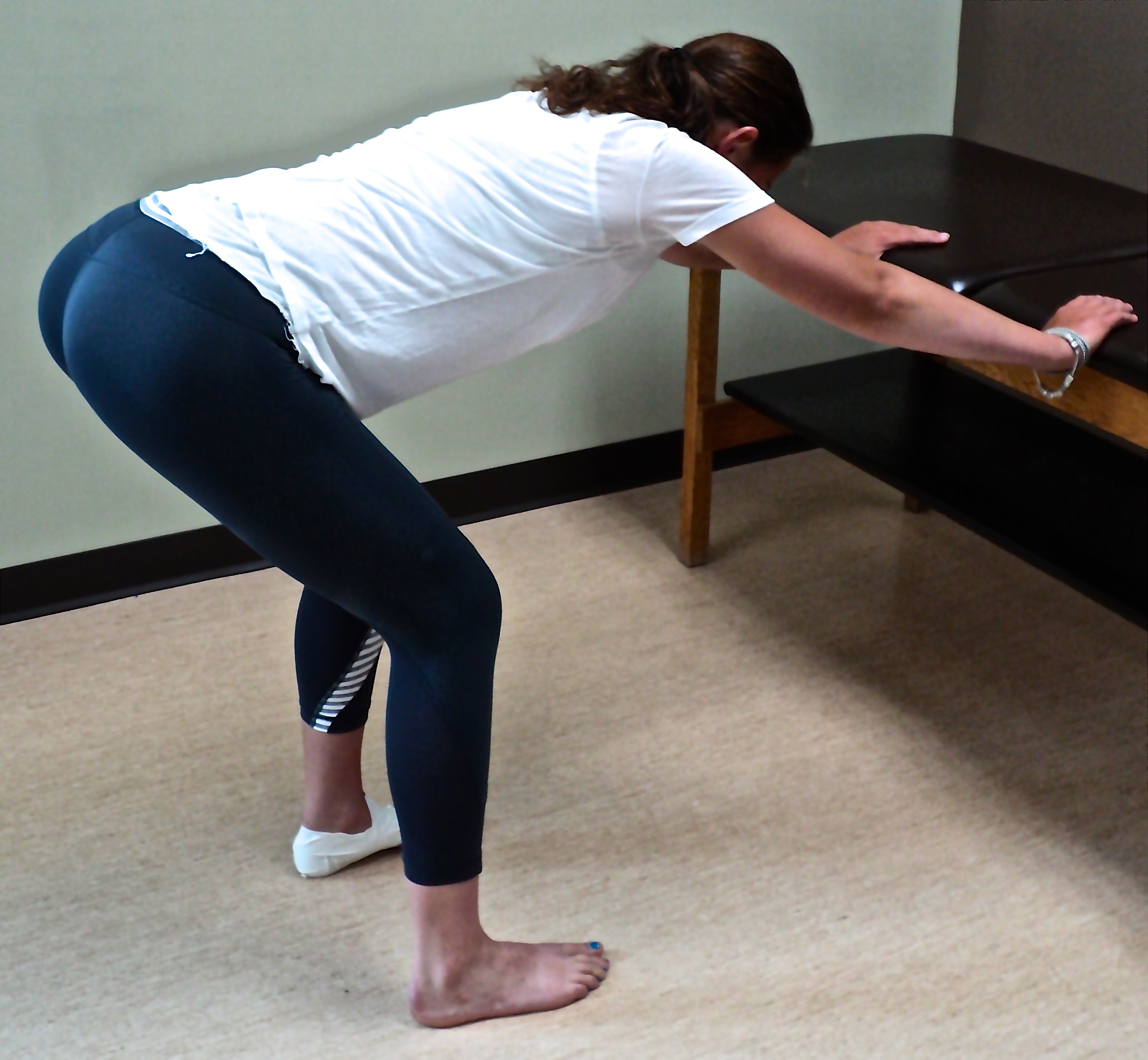 To help position and stabilize the lower leg, try tipping the pelvis forward by envisioning the pelvis as a bowl with the water at the bottom, then tipping the water out the front of the bowl. This should feel like it creates more width between the sit bones (like the butt is sticking out). Letting go of the inner thigh muscles will then allow the knee to relax away from the saddle. Holding this pelvic position and keeping the knees from pressing into the saddle will help the lower leg rest correctly on the horse’s side. Of course it must be practiced regularly in order to feel natural and become stronger. The hip fold exercise (picture 1 – from a previous article) and stretching the back of the hip and inner thigh will help this to become easier on the horse (pictures 2, 3 and 4).
To help position and stabilize the lower leg, try tipping the pelvis forward by envisioning the pelvis as a bowl with the water at the bottom, then tipping the water out the front of the bowl. This should feel like it creates more width between the sit bones (like the butt is sticking out). Letting go of the inner thigh muscles will then allow the knee to relax away from the saddle. Holding this pelvic position and keeping the knees from pressing into the saddle will help the lower leg rest correctly on the horse’s side. Of course it must be practiced regularly in order to feel natural and become stronger. The hip fold exercise (picture 1 – from a previous article) and stretching the back of the hip and inner thigh will help this to become easier on the horse (pictures 2, 3 and 4).
 For the sitting exercises the pelvis must be tipped a bit forward and the sit bones equally weighted as the stretch is added by pushing/pulling on the leg. The stretch should be felt in the back of the hip or thigh and held for 5 breaths. Doing 3-5 reps 3 or 5 times per day is ideal.
For the sitting exercises the pelvis must be tipped a bit forward and the sit bones equally weighted as the stretch is added by pushing/pulling on the leg. The stretch should be felt in the back of the hip or thigh and held for 5 breaths. Doing 3-5 reps 3 or 5 times per day is ideal.
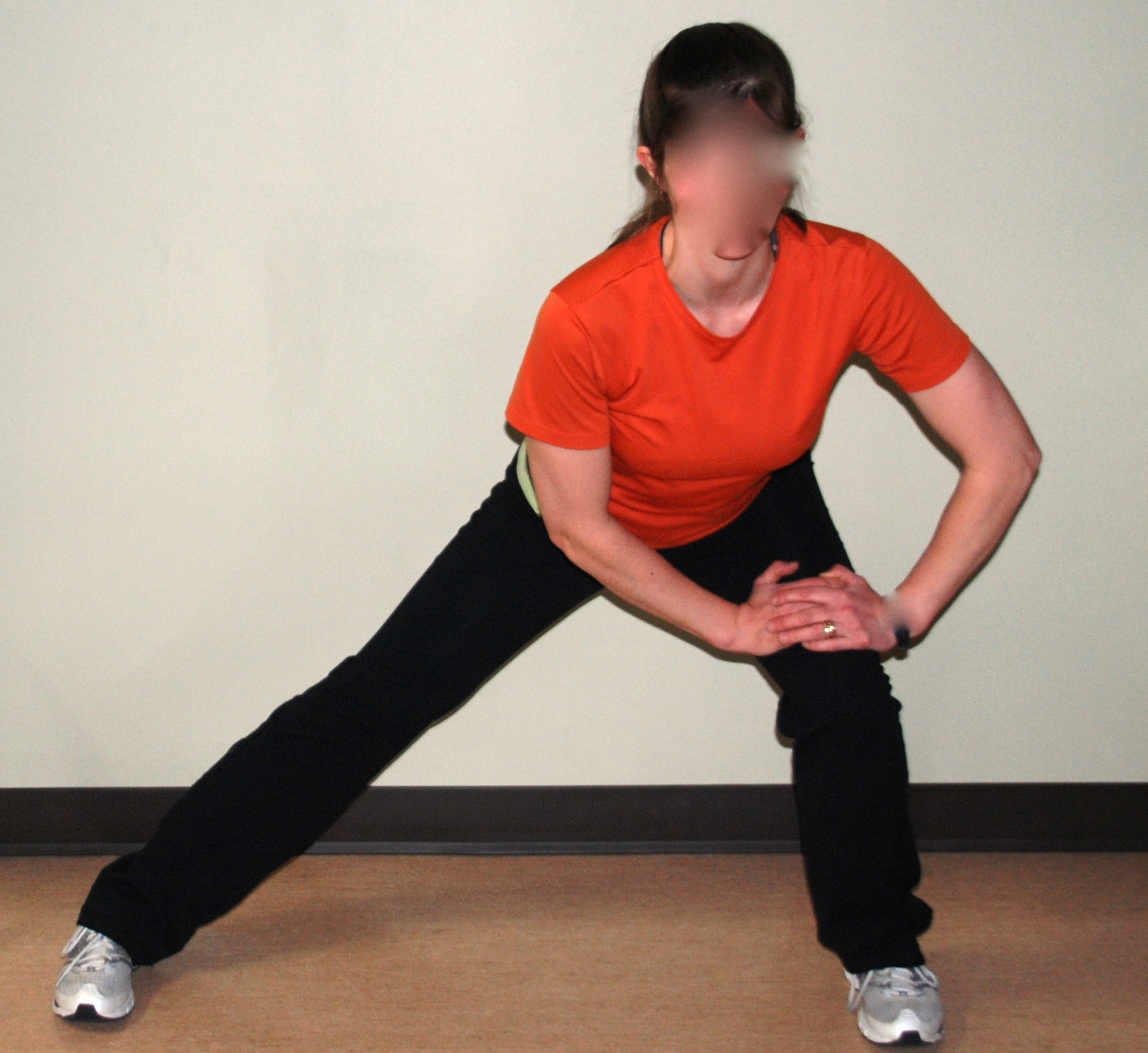
The inner thigh stretch should be held for 5 breaths 3-5 reps alternating sides 3-5 times per day.
Hip Fold Exercise!
 There are many great exercises for riders. There are actually no bad exercises, only good exercises done poorly. I am often asked, “Are squats good” and my reply is always, “Only if they are done correctly”. I say that because they are one of the most poorly done exercises of all time! Squats should target the gluteal or ‘butt’ muscles primarily. If they are felt to stress mostly the front of the thigh, or quadriceps muscle, they are being done incorrectly.
There are many great exercises for riders. There are actually no bad exercises, only good exercises done poorly. I am often asked, “Are squats good” and my reply is always, “Only if they are done correctly”. I say that because they are one of the most poorly done exercises of all time! Squats should target the gluteal or ‘butt’ muscles primarily. If they are felt to stress mostly the front of the thigh, or quadriceps muscle, they are being done incorrectly.
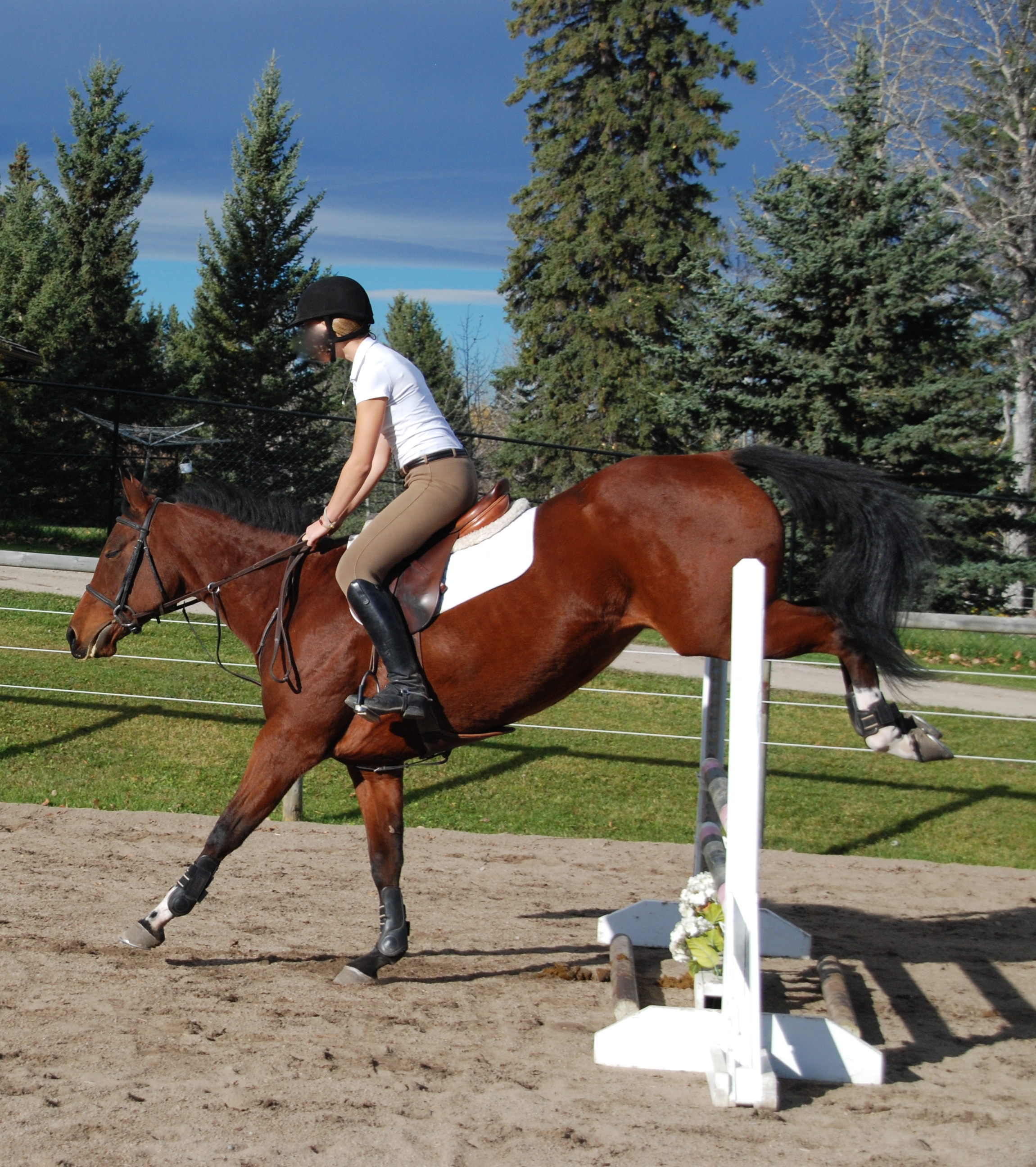 The first thing that a rider needs to be able to do in order to do a good squat is fold the hip, or make the hip crease deeper. Many riders roll too far back on their back pockets (see picture 1), which is not healthy for their back or the horse’s. These riders are often referred to as having a ‘hot seat’ and tend to jump ahead of the horse or open too early in the air because their hip angle doesn’t close easily (see picture 2). This problem is usually due to tight hips and/or weak gluteal muscles.
The first thing that a rider needs to be able to do in order to do a good squat is fold the hip, or make the hip crease deeper. Many riders roll too far back on their back pockets (see picture 1), which is not healthy for their back or the horse’s. These riders are often referred to as having a ‘hot seat’ and tend to jump ahead of the horse or open too early in the air because their hip angle doesn’t close easily (see picture 2). This problem is usually due to tight hips and/or weak gluteal muscles.
 To ensure that the hips are mobile enough, stand facing a counter with arms outstretched in front (picture 3). Allow the knees to softly bend while the sit bones push as far back as possible and the tailbone lifts. The lower back should be flat or even slightly arched. Feel the stretch in the back of the inner thigh or around the sit bones. Hold for 10 breaths and repeat 3 times. If the hips or legs are tight, this should be repeated 4-5 times per day, as well as before and after every ride. Once the hips are more mobile, doing squats correctly will be much easier. For good squat exercises stay tuned for the September edition!
To ensure that the hips are mobile enough, stand facing a counter with arms outstretched in front (picture 3). Allow the knees to softly bend while the sit bones push as far back as possible and the tailbone lifts. The lower back should be flat or even slightly arched. Feel the stretch in the back of the inner thigh or around the sit bones. Hold for 10 breaths and repeat 3 times. If the hips or legs are tight, this should be repeated 4-5 times per day, as well as before and after every ride. Once the hips are more mobile, doing squats correctly will be much easier. For good squat exercises stay tuned for the September edition!
Cross Training to Ride Your Best!
Riders commonly think that riding is enough to stay fit, especially if they ride a few horses a day. Unfortunately this is not true. Most other sports incorporate cross training into their programs, even at the amateur levels. Why should riding be any different? The best athletes, including riders, are the ones who know how to give themselves an edge! Here is why cross training gives you an advantage:
1) The more well established a movement pattern is, the less energy it requires. This means that the more a skill is performed the less fitness it provides. Research has shown that riding is not sufficient for good cardio fitness or general strength. Riders are generally less fit than athletes at similar levels in other sports. Also, jumping in competition often has a higher cardio-respiratory demand than training does and can cause a dangerously high heart rate if the rider is unfit.
 2) Doing more of the same can lead to overuse of certain body parts. This often goes unnoticed until a small spook or minor fall causes the problem to become symptomatic. Using the same muscles over and over can cause repetitive strains and joint wear and tear. (i.e. groin strains and lower back pain). The more you ride, the better you get, but the more easily you will become injured!! Cross training takes into consideration that many muscles in different parts of the body contribute to a single activity. To get the most out of any activity, and to do it safely, you must pay attention to all the muscles in your body that are involved, not just the ones directly related to that activity.
2) Doing more of the same can lead to overuse of certain body parts. This often goes unnoticed until a small spook or minor fall causes the problem to become symptomatic. Using the same muscles over and over can cause repetitive strains and joint wear and tear. (i.e. groin strains and lower back pain). The more you ride, the better you get, but the more easily you will become injured!! Cross training takes into consideration that many muscles in different parts of the body contribute to a single activity. To get the most out of any activity, and to do it safely, you must pay attention to all the muscles in your body that are involved, not just the ones directly related to that activity.
Andrea Strain, trainer and Grand Prix rider, feels strongly about the benefits of cross training. “Working out gives me additional body awareness, especially when targeting weak areas. Doing uni-lateral exercises with a mirror draws my attention to any asymmetries. I can see differences such as a wobble of my knee, or a dropped shoulder…things that are likely also occurring on take off or landing of a jump. I can modify these movements in the controlled atmosphere of the gym, helping the new movements become more natural for when I ride. I also find that working out gives me an edge in my fitness level. Horse shows can be tiresome, and being fit for them is essential to being as successful at the end of the week as at the beginning!”
3) Injuries can be prevented.
Ann Karrasch, US grand prix rider, has been working out regularly for the past 2 years. She concludes that, “Cross training has not only improved my posture and appearance, but has allowed my position on the horse to be stronger with more endurance and versatility. Horses do unexpected things sometimes and having more balanced body strength keeps me from being stuck and braced in one position, therefore improving my reaction time and adaptability. I fall off less easily!”
Vinton Karrasch, Ann’s husband and fellow grand prix rider, agrees and states, “ The strength and endurance I have gained from cross training has made me more resilient to wear and tear. I feel fitter and stronger now than even 10-15 years ago and expect that this will add longevity to my career as a rider.”
4) If injured or are not able to fully train or compete, cross training can maintain a level of fitness that allows a more speedy return to full form as well as assisting with the healing process.
After recovering from injury, Ben Asselin, Canadian team member, noted that, “Cross training and doing rehab exercises really helped improve my stability in the saddle and enabled me to understand and feel how my whole body is used to ride. Pinpointing my areas of weakness has allowed me to be even stronger than before.”
F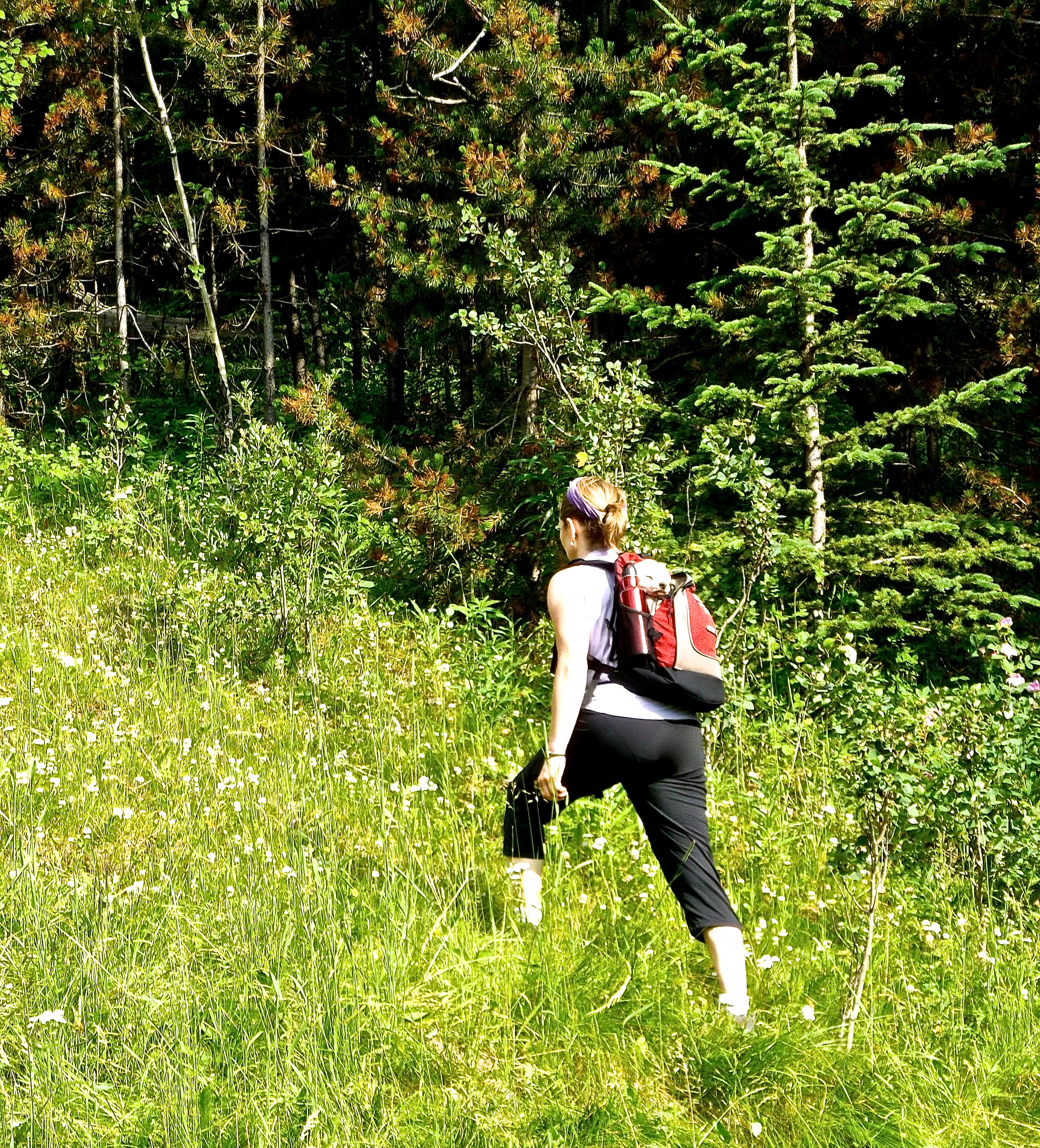 or riders, cross training can mean any activity outside of riding and many different activities can be used to ensure total fitness. Some research is indicating that exercises targeting the ability to hold a position for a prolonged period (i.e. plank and wall squats) and that improve power (the ability to be strong with speed), are the most beneficial for improving riding abilities. Cross training takes time, but can be fun and will lead to becoming the best rider that you can be!
or riders, cross training can mean any activity outside of riding and many different activities can be used to ensure total fitness. Some research is indicating that exercises targeting the ability to hold a position for a prolonged period (i.e. plank and wall squats) and that improve power (the ability to be strong with speed), are the most beneficial for improving riding abilities. Cross training takes time, but can be fun and will lead to becoming the best rider that you can be!
See next edition for good rider exercises.
The human spine in motion.
“Pull your shoulders back” is a phrase I often comment on. It accompanies “straighten up’” and “push your chest out.” The image this conjures up is one of elegance, poise and ‘good posture’. That is, if there was no movement required and the rider could just sit still and look pretty. What these corrections most often create is stiffness. The spine is designed to be curved like an ‘S’ (when viewed from the side) for the optimum combination of strength and mobility (it is all about physics). The lower back should be slightly arched and the upper back mildly rounded. It is a matter of degree and everyone is designed to have a slightly different amount of curve in their spine. Never in riding should either of these curves be reversed as that compromises both the mobility and the health of the spine.
The job of the spine in riders, besides some of its more obvious jobs like providing a place for the head to sit, is to absorb the movement of the pelvis as it rocks on the hips in unison with the horse’s back (we are talking full seat here). The spine must be able to undulate so that the head can stay still (bobbling heads are a sure sign of a stiff spine or hips) and the movements of the horse not be transmitted to the arms and hands. The video I have here demonstrates how mobile the spine needs to be to effectively allow the body to be independent of the seat.
So instead of ‘pulling the shoulders back’, consider ‘lengthen the spine’, ‘open the collar bones’ , ‘grow tall equally in the front and back of your body ‘. These more subtle corrections are even more important in the aging rider as the overall spinal mobility begins to decline. Lower back pain often occurs in riders of all ages who use the arched middle back position over fences. Riders who find it difficult to maintain the curves of their spine while ‘staying tall’ and/or closing their hip angle often have weak or inefficient core muscles. There are very basic exercises that riders can practice during the activities of their daily life to improve their riding posture (see next issue).
“Heels down… and stop pinching your knee.”
That darn heel. It just won’t listen to you or your coach. You push it down, forget about it for a few seconds and it pops right back up again! You may also tend to lose a stirrup, have knee pain (especially with posting and jumping) or have more wear on one knee, boot or saddle flap. You may not have a heel problem! There is a muscle on the top of your thigh, near where your leg joins your pelvis, that can become tight and is often more achey with sitting. READ MORE…

